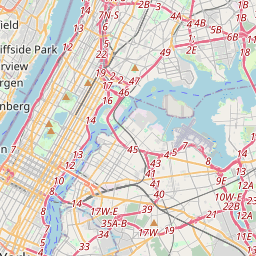Inscription
Foley Square
—1.88 acres —
Following this renovation, Thomas Paine Park was officially integrated into Foley Square and rededicated.In 2013, George Edwin Bissell's sculpture of Abraham de Peyster (1657-1728), former New York City mayor (1691-1694), was reinstalled in the park. The relocation of this sculpture, which was originally cast in 1896, to this downtown park is particularly apt given its historical associations to early Dutch settlement and later immigrant arrivals. On July 8, 2014, the 357th anniversary of de Peyster's baptism, the sculpture was rededicated in the presence of more than two dozen de Peyster descendants, city officials, and the Netherlands Consul General.
The park's namesake, Thomas Paine, was an Englishman from Thetford in County Norfolk. He spent his early years committed to justice in Britain, speaking out for social equity and lobbying for higher wares. In 1774, at the urging of Benjamin Franklin, then colonial ambassador to Britain, Paine immigrated to Philadelphia. He became a close associate of Franklin, the other founding fathers, and the Marquis de Lafayette. His writings profoundly influenced the course of the American Revolution and the creation of the United States government.
Paine published the unsigned pamphlet Common Sense on January 10, 1776. It advocated rising up in arms against Britain, and many of its ideas are echoed in the Declaration of Independence. His description of a representative government became the basis for modern democracy anchored by a written constitution. Paine's sixteen American Crisis essays boosted morale during the darkest days of the Revolutionary War. For his service to the fledgling nation, New York State later gave Paine a 277-acre farm in New Rochelle, new York.
His most famous work, Rights of Man (1791), was written after the French Revolution and proposes that government is responsible for protecting the natural rights of its people. Many of Paine's ideas were strikingly far sighted. He advocated for the abolition of slavery, defended freedom of thought and expression, and proposed an association of nations to avert the spread of conflicts.
In 1802, Paine returned to America, where he was the guest of President Jefferson, to whom he recommended the Louisiana Purchase. Paine tried to settle down on his farm, but his declining health led him to move to Manhattan in 1804. He died in Greenwich Village on June 8, 1809. His remains were buried on his New Rochelle farm. It was not until several years after his death that dedicated friends and biographers began to remind the public of Paine's contributions to American freedom and democracy.
"My country is the world, and my religion is to do good."
Thomas Paine, Rights of Man Part Two (1792)
NYC Parks
Details
| HM Number | HM2DIB |
|---|---|
| Tags | |
| Marker Condition | No reports yet |
| Date Added | Monday, January 14th, 2019 at 10:01am PST -08:00 |
Pictures
Locationbig map






| UTM (WGS84 Datum) | 18T E 584223 N 4507568 |
|---|---|
| Decimal Degrees | 40.71473333, -74.00285000 |
| Degrees and Decimal Minutes | N 40° 42.884', W 74° 0.171' |
| Degrees, Minutes and Seconds | 40° 42' 53.04" N, 74° 0' 10.26" W |
| Driving Directions | Google Maps |
| Area Code(s) | 212, 917, 646, 718, 347 |
| Which side of the road? | Marker is on the right when traveling South |
| Closest Postal Address | At or near 105 Duane St, New York NY 10007, US |
| Alternative Maps | Google Maps, MapQuest, Bing Maps, Yahoo Maps, MSR Maps, OpenCycleMap, MyTopo Maps, OpenStreetMap |
Is this marker missing? Are the coordinates wrong? Do you have additional information that you would like to share with us? If so, check in.
Nearby Markersshow on map
Maintenance Issues
- Is this marker part of a series?
- What historical period does the marker represent?
- What historical place does the marker represent?
- What type of marker is it?
- What class is the marker?
- What style is the marker?
- Does the marker have a number?
- What year was the marker erected?
- Who or what organization placed the marker?
- This marker needs at least one picture.
- Can this marker be seen from the road?
- Is the marker in the median?

Comments 0 comments